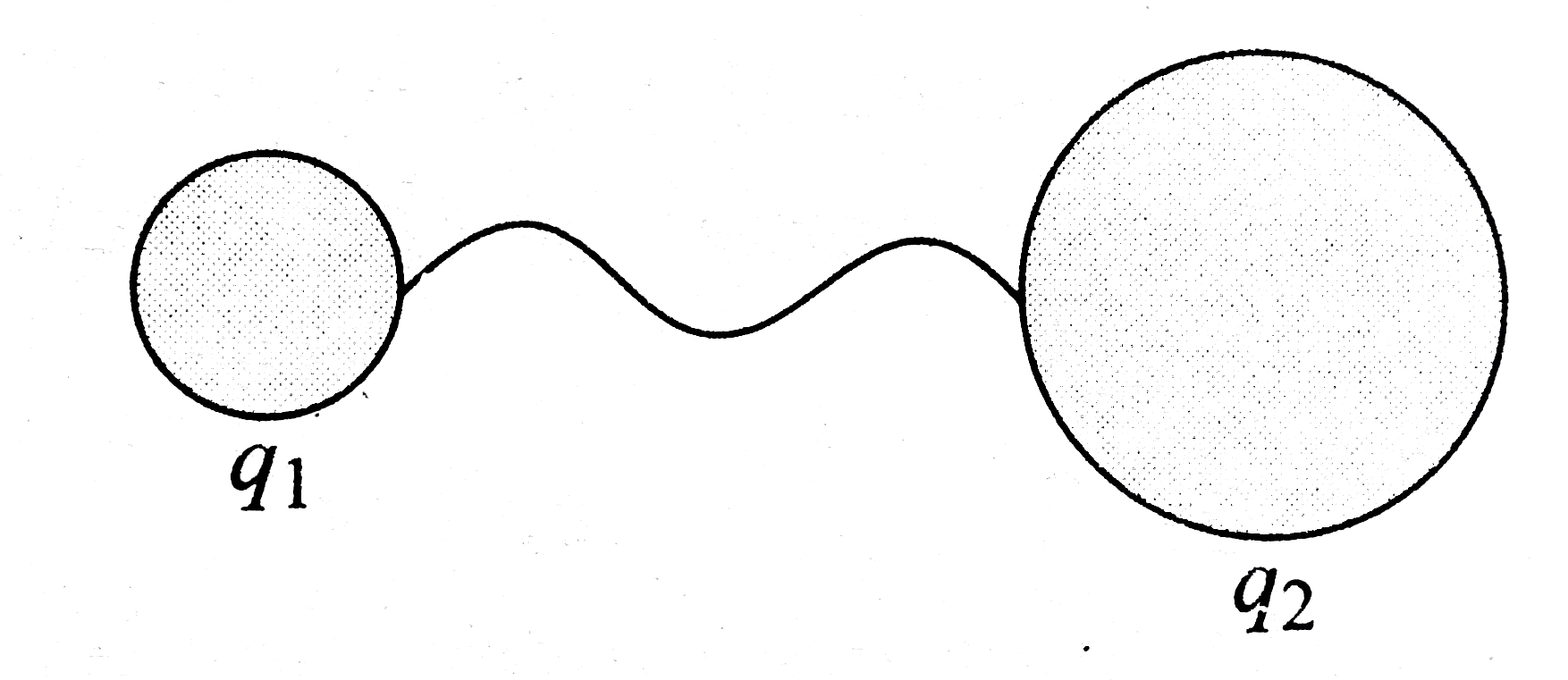Two conducting spheres of radii r and 2r are placed at very large separation. Each sphere possesses charge Q. These spheres are connected with a conducting wire of resistance R. Then, which of the following is true?
Initial current is Q8π∈0rR
Initial current is Q4π∈0rR
Current reduces to half the initial current after time 8π∈0rRln2
Current reduces to half the initial current after time 8π∈0rRln23
The correct Answer is:A, D
To solve the problem of two conducting spheres of radii r and 2r connected by a wire of resistance R, we will follow these steps:
Step 1: Determine the Initial Potentials of the Spheres
The potential V of a charged sphere is given by the formula:
V=kQr
where k=14πϵ0.
For Sphere A (radius r):
VA=kQr
For Sphere B (radius 2r):
VB=kQ2r
Step 2: Calculate the Potential Difference
The potential difference ΔV between the two spheres is:
ΔV=VA−VB=kQr−kQ2r
This simplifies to:
ΔV=kQr(1−12)=kQr⋅12=kQ2r
Step 3: Calculate the Initial Current
Using Ohm's law, the current I flowing through the wire can be calculated as:
I=ΔVR=kQ2rR=kQ2rR
Substituting k=14πϵ0:
I=Q8πϵ0rR
Step 4: Determine the Capacitance of the Spheres
The capacitance C of a conducting sphere is given by:
C=4πϵ0r
For Sphere A:
C1=4πϵ0r
For Sphere B:
C2=4πϵ0(2r)=8πϵ0r
Step 5: Calculate the Equivalent Capacitance
Since the spheres are connected in series, the equivalent capacitance Ceq is given by:
1Ceq=1C1+1C2
Substituting the values:
1Ceq=14πϵ0r+18πϵ0r=2+18πϵ0r=38πϵ0r
Thus,
Ceq=8πϵ0r3
Step 6: Determine the Time for Current to Become Half
Using the formula for current decay in a capacitor:
I(t)=I0e−tRC
Setting I(t)=I02:
I02=I0e−tRC
Dividing both sides by I0:
12=e−tRC
Taking the natural logarithm:
−ln(2)=−tRC⟹t=RCln(2)
Substituting Ceq:
t=R⋅8πϵ0r3ln(2)
Conclusion
The initial current I is given by:
I=Q8πϵ0rR
And the time t at which the current becomes half is:
t=R⋅8πϵ0r3ln(2)
The potential V of a charged sphere is given by the formula:
V=kQr
where k=14πϵ0.
VA=kQr
VB=kQ2r
The potential difference ΔV between the two spheres is:
ΔV=VA−VB=kQr−kQ2r
This simplifies to:
ΔV=kQr(1−12)=kQr⋅12=kQ2r
Using Ohm's law, the current I flowing through the wire can be calculated as:
I=ΔVR=kQ2rR=kQ2rR
I=Q8πϵ0rR
The capacitance C of a conducting sphere is given by:
C=4πϵ0r
For Sphere A:
C1=4πϵ0r
For Sphere B:
C2=4πϵ0(2r)=8πϵ0r
Since the spheres are connected in series, the equivalent capacitance Ceq is given by:
1Ceq=1C1+1C2
Substituting the values:
1Ceq=14πϵ0r+18πϵ0r=2+18πϵ0r=38πϵ0r
Thus,
Ceq=8πϵ0r3
Using the formula for current decay in a capacitor:
I(t)=I0e−tRC
Setting I(t)=I02:
I02=I0e−tRC
Dividing both sides by I0:
12=e−tRC
Taking the natural logarithm:
−ln(2)=−tRC⟹t=RCln(2)
Substituting Ceq:
t=R⋅8πϵ0r3ln(2)
The initial current I is given by:
I=Q8πϵ0rR
And the time t at which the current becomes half is:
t=R⋅8πϵ0r3ln(2)
Similar Questions
Knowledge Check
A conducting sphere is negatively charged. Which of the following statements is true?
AThe charge is uniformly distributed throughout the entire volume.BThe charge is located at the center of the sphere.CThe charge is located at the bottom of the sphere because of gravity.DThe charge is uniformly distributed on the surface of the sphere.
Two conducting spheres of radiiR1andR2 are kept widely separated from each other . What are their individual capacitances?
View SolutionTwo spherical conductors of radii R1andR2 are separated by a distance much larger than the radius of eighter sphere. The spheres are connected by a conducting wire as shown in (Fig. 3.128). If the charges on the spheres in equilibrium are q1andq2, respectively, what is the ratio of the field strength at the surfaces of the spheres ?
 .
.
View SolutionTwo conducting spheres of radii r and 3r initially have charges 3q & q respectively. Their separation is much larger their radii. If they are joined by a conductor of high resistance, the force between them will :
View SolutionTwo concentric spherical conducting shells of radii r and R (r<R) carry charges q and Q respectively . The two shells are now connected by a conducting wire. The final charge on the inner shell is
View SolutionThree plates A, B and C are placed close to each other with +Q charge given to the middle plate. The inner surfaces to A and C can be connected to earth through plate D and keys K1 and K2 . The plates D is a dielectric slab with dielectric constant K1 then the charge that will flow through plate D and keys K1 and K2 . The plate D is a dielectric slab with dielectric constant K, then the charge that will flow though plate D when K2 is closed and K2 is open is

View SolutionTwo conducting spheres of radii 6km and 12km each, having the same charge 3×10−8C, are kept very far apart. If the spheres are connected to each other by a conductiong wire, find
i. the direction and amount of charge transferred and
ii. final potential each sphere.
View SolutionConsider two concentric metalic shell's of radii R and 2R. The inner shell is having charge Q and outer shell is uncharged. If they are connected with a conducting wire. Then,
View Solution
